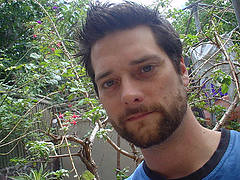Human Stigmergy Part 1

As far as my explorations have uncovered, little to no research has been done on applying stigmergy to human activity and communication. There have been a few very brief mentions here and there, the most significant in some ways being by Theraulaz & Bonabeau in "A Breif History of Stigmergy" from Artificial Life journal, Volume 5, Issue 2 - Spring 1999, page 102:
Chemical trails that are produced by some ants species [10, 23] muleteer trail networks, and even dirt tracks and trail systems in man [31, 32] result from interactions of this kind.
[31 refers to Modelling the evolution of human trail systems, Dirk Hebling, Joachim Keltsch & Peter Molnar; while 32 refers to Active walker model for the formation of human and animal trail systems, Dirk Helbing, Frank Schweitzer, Joachim Keltsch, Péter Molnár]
Another excellent mention of human stigmergy, although less formal, is in the comment posted by Dylan Shell to Joe Gregorio's great blog post on stigmergy. Here he says:
Another example, perhaps just as old, and even more damaging in some cases, is the process with which people choose illegal dumping grounds. A necessary feature is some degree of seclusion, or at least shelter from the prying eyes of the law. However, we find that once a place has been chosen by some offender, their dump adds a stronger justification to others for that site.


6 Comments:
Mark...
I'm just learning about the concept of stigmergy and stumbled upon your blog (is this stigmergy in action?). I am the author of a website/blog that offers resources/tools for student leadership. I think that the idea of stigmergy has implications in this field. A student leader has the opportunity to serve in a position for typically one year. That student leader is deeply influenced by the work of the student leader's that came before him or her. Plus, the legacy that he or she leaves will have a significant impact on the response that the following student leader has in that position.
I'd be interested in hearing some of your thoughts or take a look at anything that you've come across where stigmergy has been applied to human dynamics and interactions.
tim
Hi Tim,
Your project sounds very interesting, and one that I think stigmergy could be applied to - although the whole notion of human stigmergy is completely new in that there is virtually no research or consensus around what this means (as far as I'm aware of).
In the coming weeks I'll be posting more on my research in this area (linked to my PhD) and would be the only such info that I could currently point you to. This of course doesn't mean that it does not exist, I just don't know about it yet - if you happen to come across any, please let me know ;-)!
(And yes, this is stigmergy in action - in that my encoding of my environment spurred you to also do so. However, now that we are communicating directly, this is less stigmergic and more computer mediated. However this is precisely the blurry domain that I'm exploring further right now.)
Please feel free to email me at m.elliott at unimelb.edu.au if you’d like to discuss further.
Mark,
You might be interested in a study we recently produced on human-human stigmergy:
[1] H. V. D. Parunak. A Survey of Environments and Mechanisms for Human-Human Stigmergy. In D. Weyns, F. Michel, and H. V. D. Parunak, Editors, Proceedings of E4MAS 2005, vol. LNAI 3830, Lecture Notes on AI, pages 163-186. Springer, 2006. www.newvectors.net/staff/parunakv/HumanHumanStigmergy2005.pdf.
Best,
Van Parunak
Wow, thank you very much indeed Van! That's exactly the type of research I've been looking for. I think there is very little chance that I won't be contacting you to pick your brain :-D I'll get reading, and thanks again!!!
Hi Mark. Maybe you can find interesting this article
[Alessandro Ricci, Andrea Omicini, Mirko Viroli, Luca Gardelli, Enrico Oliva] Cognitive Stigmergy: A Framework Based on Agents and Artifacts. The Third International Workshop on Environments for Multiagent Systems (E4MAS 06). To be held at The Fifth International Joint Conference on Autonomous Agents & Multiagent Systems (AAMAS 2006) - Future University-Hakodate, Japan, May 8, 2006.
It is somewhat related to what is doing van Parunak, although less developed. You can find it on my web page.
Luca
Thanks Luca, it's great to see that your paper is coming from a trans-disciplinary perspective - this is very much how i tend to view my own approach. I'll read it and let you know if i have any worthwhile insights - thanks for sharing!
mark
Post a Comment
<< Home